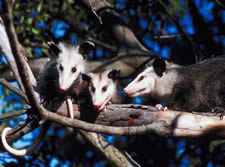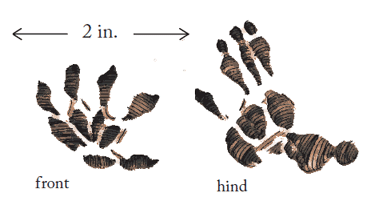Wildlife - Species

Species Specific Regulations
Opossum
Licenses: Hunting License required.
Limits: Weapon restrictions according to game zones please check for Limitations.
Opossum (Didelphis virginiana)
Description
Females are usually smaller than males. The underfur is white at the base and black at the tip and is penetrated by longer coarse white guard hairs. This gives the opossum a general grayish white appearance. The tail is hairless and is adapted for grasping.

Opossum tracks
Average Size
The opossum weighs 4 to 7 lbs. and stands 6 to 8 inches high at the shoulder.
Life Expectancy
Approximately 2-4 years.
Preferred Habitat
The opossum is one of the most adaptable animals in North America. The diversity of food items it will utilize allows it to live in almost all habitats in South Carolina. Opossums thrive in both woodlands and farmlands and are also commonly found in residential areas.
Range
The only marsupial native to the United States, the opossum is found from the plains states to the Atlantic coastal states, and from Mexico to southern Ontario. They were introduced in California. Opossums are abundant in every county in South Carolina.
Food Habits
The opossum diet is the most varied of all furbearers, with insects being the most important item. Opossums are known to eat fruits, crayfish, snails, worms, frogs, salamanders, dead fish and other carrion, mice, snakes, birds' eggs and sometimes even birds and rabbits.
Reproduction
Peak Breeding Activity
The opossum is polygamous, breeding from January through August.
Females produce at least 2 litters annually in their southern range. After gestation, the young crawl from the genital opening to the pouch where they each attach to a nipple for a period of 6 to 7 weeks. This peculiar development trait is characteristic of the marsupial group. At about 80 days, the young leave the pouch and often ride on the mother’s back. Young are weaned at 95 to 100 days and disperse to be on their own shortly afterward.
Gestation
13 days and the average litter size is 7 to 11
Miscellaneous
Opossums are subject to a high degree of predation, numerous parasites, and highway mortality.
The opossum is one of the most common furbearers in South Carolina. Because of their relatively low fur value, very few opossum pelts are sold. Opossums are usually caught incidental to trapping for other furbearers and are often hunted with dogs. Opossum meat is sometimes eaten by sportsmen
Publications and Literature
Baker, O.E., Carmichael, D. Breck, South Carolina Furbearers. Wildlife and Freshwater Fisheries Division. Columbia, South Carolina
Fur Harvest Hunting and Trapping are provided in the Fur Harvest Brochure which is a summary of the state statutes regarding the commercial harvest of furbearers. Applicable statutes are listed in parentheses at the end of each section of this brochure. Copies of actual statutes of the SC Code of Laws are available online from the SC Legislature at www.scstatehouse.gov or by writing: Furbearer Program, SC Department of Natural Resources, P.O. Box 167, Columbia, SC 29202.
Some of the files above are provided in the Adobe® Acrobat® (PDF) format. Adobe® Reader® is required to open these files and is available as a free download from the Adobe® Web site.
Jay Butfiloski - Furbearer Project Supervisor
SCDNR Furbearer Project
P. O. Box 167
Columbia, SC 29202-0167
Phone: 803-734-3886
Fax: 803-734-6020
E-mail: ButfiloskiJ@dnr.sc.gov

